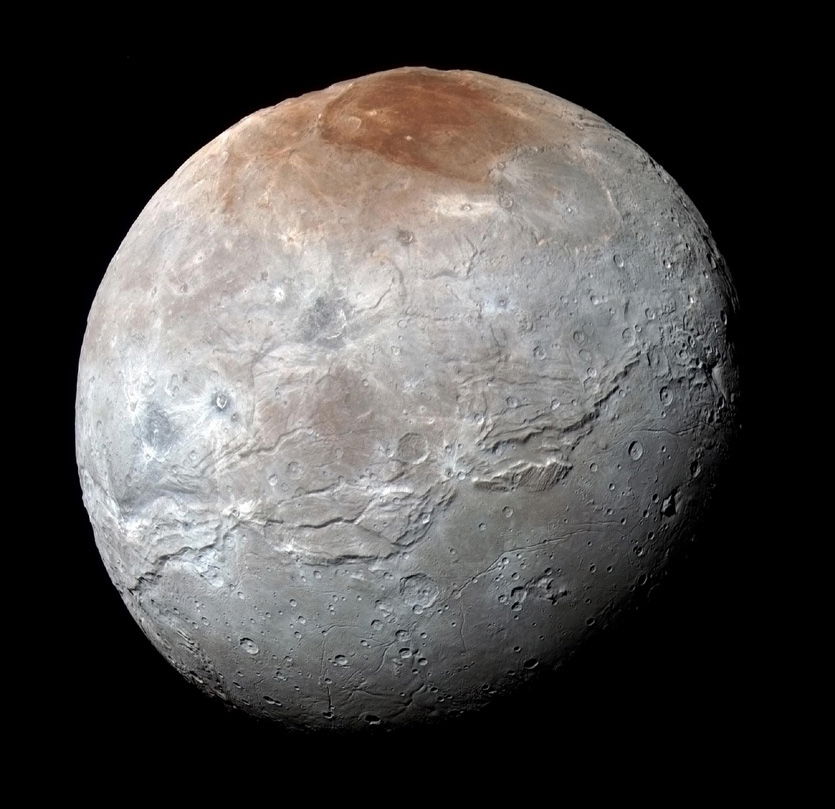The Puzzle of Pluto
When a probe flew by Pluto, it made a shocking discovery: the surface is young. Astronomers are still scrambling to explain why.
Since it’s discovery in 1930, tiny Pluto has been a mystery. Lying at the edge of the solar system far from earth, Pluto is visible only with large telescopes. Even then, it appears as a small, faint speck (as a professional astronomer, I’ve seen Pluto only a few times). In 2006 Pluto suffered the indignity of being demoted from the ranks of planets. Astronomers that year created a new class of objects, dwarf planets, to accommodate Pluto and a few other large asteroids. Pluto is now viewed as one of the largest of the trans-Neptunian objects, a group of icy asteroids orbiting the sun beyond the orbit of Neptune, the most distant planet from the sun.
Our view of Pluto changed dramatically in the summer of 2015, with the first photographs from the New Horizons spacecraft that flew past Pluto. Launched a decade earlier, New Horizons carried a suite of scientific instruments, including its superb camera, to explore Pluto in depth for the first time. To say that astronomers were shocked would be to put it mildly. Astronomers thought Pluto’s surface would be saturated with craters, but it wasn’t.
Bringing Pluto Into Focus
We've come a long way in our view of Pluto. It was little more than a dot when the Hubble Telescope took its first image in 1994. A new Hubble image in 2010 showed a varied surface but no detail. The New Horizons flyby changed all that, revealing a shocking lack of craters.

Photos of Pluto: May 16, 1994 (top left), February 4, 2010 (bottom left), July 13, 2015 (right)
Mysterious Missing Craters
Why did astronomers expect Pluto’s surface to have many craters? This idea stems from a common belief that the solar system formed naturalistically over billions of years. The solar system supposedly formed from a large cloud of gas and dust 4.5 billion years ago. According to this theory, most of the matter in the solar system fell to the center to form the sun. The remaining material flattened into a disk, in which small particles began to stick together. These planetesimals gradually grew in size to form the planets, their satellites, and asteroids and comets.
Naturalistic astronomers believe objects beyond Neptune’s orbit failed to reach the size of planets. These smaller objects, as well as smaller objects orbiting the sun within the region of the planets, are called asteroids. As asteroids formed, the argument goes, other small objects crashed into them and made them larger. These small bodies left craters on the surfaces of asteroids.
Craters supposedly accumulated on planets as well, but the surface of a planet is generally much more dynamic, showing significantly fewer craters than asteroids because volcanic eruptions and even weather can fill in and eventually cover ancient craters. This is the theory that most astronomers use to explain the limited number of impact craters on earth. The moon, in contrast, is less active than the earth, with very little volcanic or weather activity. So its surface still bears testament to many impacts.
Similarly, the small bodies of the solar system, including asteroids and Pluto, supposedly lack geological and significant weather processes. So their surfaces should be covered with craters. Several spacecraft have visited asteroids and sent back images revealing many craters on their surfaces. Most of the moons (or satellites) of the planets possess many craters as well. So astronomers expected Pluto to be more heavily cratered than our moon.
To their surprise, the images from New Horizons showed very few craters on Pluto’s surface. Pluto’s largest satellite, Charon, has more craters than Pluto, but far fewer than expected.
Because Pluto rotates so slowly and New Horizons spent so little time in Pluto’s vicinity, it could photograph only about half of Pluto’s surface in full sunlight at high resolution. Only a few small regions showed an appreciable number of craters.
The most outstanding feature seen on Pluto’s surface is Tombaugh Regio, a large, heart-shaped region. Tombaugh Regio is light colored because it is made of various ices. Little of this ice appears to be water. Instead, most of it is primarily made of nitrogen, with a bit of carbon monoxide and methane. These ices are not as thick (viscous) as water ice, so they flow more easily, but they would likely require a heat source to trigger the motion. Tombaugh Regio has few craters, and Sputnik Planum, the western half of Tombaugh Regio, has no visible craters. In the evolutionary paradigm, this suggests that this region formed recently, so it must be young.

The most outstanding feature seen on Plutoʼs surface is Tombaugh Regio, a large heart-shaped region. Tombaugh Regio has few craters, and Sputnik Planum, the western half of Tombaugh Regio, has no visible craters.
Evidence of an Active Planet
Why do Pluto and Charon have so few craters? Naturalistic astronomers don’t believe that Pluto itself is young, but that the surface is young. How can the surface be young but not Pluto itself? Their assumption is that material spewed from recent geological activity must have covered many craters.
Furthermore, some of the ice on Pluto’s surface appears to have moved in what amounts to glacial activity. This is not the sort of thing that one would expect on an old, dead world, either.
There are signs of other recent geological activity. Towering mountain ranges on Pluto rival the Rockies in height. High mountains tend to sink back down under their own weight, something that should have happened long ago if the mountains are old. The process of leveling would be speeded up if Pluto’s interior has liquid water, which some planetary scientists are now claiming, based upon certain icy surface features.
What is responsible for Pluto’s geological activity? Astronomers think that this can happen one of two ways. One possibility is an internal source of heat. For instance, some suggest it may be like the earth, which has radioactive materials inside the planet that generate heat as they decay. Most scientists think this process keeps the earth hot inside. This will not work for Pluto, however. Pluto does not appear to have radioactive materials, which would make it very dense. Its density is very low, less than half the density of the earth. This low density is consistent with Pluto being a mixture of ice and rock. These rocks would not have sufficient radioactivity to heat Pluto for billions of years.
A second heating mechanism could be tidal flexing. Large astronomical objects can stretch and squeeze their smaller neighbors. Astronomers have invoked this process to explain why no craters exist on the surface of Io, the innermost large satellite of Jupiter. They say that Jupiter has caused tidal flexing on Io, generating many volcanoes that periodically recover Io’s surface. Alternately stretching and compressing with each orbit, Io’s interior continually heats up, much as a metal wire heats up when we bend it rapidly back and forth. With the vast difference in size between Jupiter and Io, tidal flexing seems like a reasonable explanation for Io’s smooth surface, though doubt remains whether this mechanism is strong enough to explain Io’s volcanism. This mechanism may work on Io, but it cannot work at all on Pluto. No massive bodies orbit nearby.
With both possibilities eliminated, how do astronomers explain the surfaces of Pluto and Charon? No explanation has been forthcoming yet. Astronomers may eventually suggest that Pluto and Charon just happened to have experienced some rare, catastrophic event recently (in the past few hundred million years). However, blaming a rare event amounts to an arbitrary rescuing device. It cannot be proven, so it hardly constitutes science.
A Biblical Answer
Another explanation—anathema to evolutionary astronomers—is possible. What if Pluto is not nearly as old as many scientists think? If Pluto is very young, its surface may not have had enough time to accumulate many craters. Or perhaps Pluto was created with internal heat that is still there. That could drive geological processes that could not only erase many craters but also explain the gases that are released from within Pluto to sustain a thin atmosphere.
But if Pluto is billions of years old, none of its internal heat would remain. Scientists who believe in biblical creation would expect evidences of a young Pluto, and those are what we see.
If the solar system is young, you might be wondering why some bodies, such as the earth’s moon and Mercury, have numerous craters on their surfaces. One suggestion is that most craters may be the result of the rapid process that God used on Day Four to assemble solar system bodies. God may have made some bodies with internal heat, such as Io and Pluto, so that their surfaces have been refreshed, largely removing original craters.
Another perplexing problem for those who believe in billions of years is Pluto’s thin nitrogen atmosphere. Pluto’s gravity is insufficient to hold on to its atmosphere, so it should rapidly dissipate. However, if Pluto is only thousands of years old, then there may not have been enough time for Pluto to have lost its atmosphere. [Editor’s note: (October 2021) Pluto’s gravity is weak, so there is a slow loss of nitrogen gas to space. Though we have the authority of God's Word to give the age of Pluto as only about 6,000 years, Pluto has a huge reserve of nitrogen ice that could gradually sublime to replace the gas lost and so maintain a steady state. See Easy Come, Easy Go: Pluto’s Changing Atmosphere for more information.]
At any rate, Pluto appears unique in the solar system. Why did God make Pluto this way? One possible reason is that God wanted to confound man’s thinking and to show us that He truly made the universe in the manner and time frame found in the Bible. Pluto has turned out to be a fascinating, dynamic world. We even see evidence that glaciers once helped shape Pluto’s surface. Glaciers generally are unknown on surfaces other than the earth (with the possible exception of Jupiter’s satellite Europa, which appears to be completely covered by a thick layer of water ice). Bible-believing Christians look forward to new developments in man’s understanding of Pluto.
Plutoʼs Moon: Another Perplexing World

Charon is the largest and most interesting of Pluto’s five satellites, or moons. While Charon has more craters than Pluto, it has far fewer than expected. This means it has not been around very long (the creationist view), or the ice on the surface has been active recently and covered the craters. Its southern hemisphere has particularly few craters. Yet as with Pluto, it has tall mountains. One mountain rises out of a depression like a castle in a moat. Its origin is a mystery.
One difference between Pluto and Charon is the kind of ice on each surface. Pluto’s ice is dominated by nitrogen and methane (the same gas we call natural gas here on earth), but Charon’s ice appears to be mostly water. No one yet knows exactly why they differ. Water requires much higher temperatures to melt, so the water ice on Charon is far less likely than Pluto’s ice to have melted recently. Furthermore, water ice is more viscous (“thicker” and more resistant to changing shape) than many other ices, so it is less likely to flow. If it has been inactive for a long time, we should find far more craters.
As with Pluto, the only explanation that evolutionists can come up with is that Charon has been geologically active in the relatively recent past. But we don’t know what mechanism could have produced all of this activity. These mysterious bodies at the edge of the solar system continue to confound evolutionary theory but give testimony to the Creator.
Related Videos
Comets and TNOs (Trans-Neptunian Objects) Excerpt
Answers Magazine
October–December 2016
Your irresistible urge to snatch up that cute little puppy and hug it for all youʼre worth isnʼt just a feeling. Itʼs science.
Browse Issue SubscribeRecommended Resources

Answers in Genesis is an apologetics ministry, dedicated to helping Christians defend their faith and proclaim the good news of Jesus Christ.
- Customer Service 800.778.3390
- © 2024 Answers in Genesis







